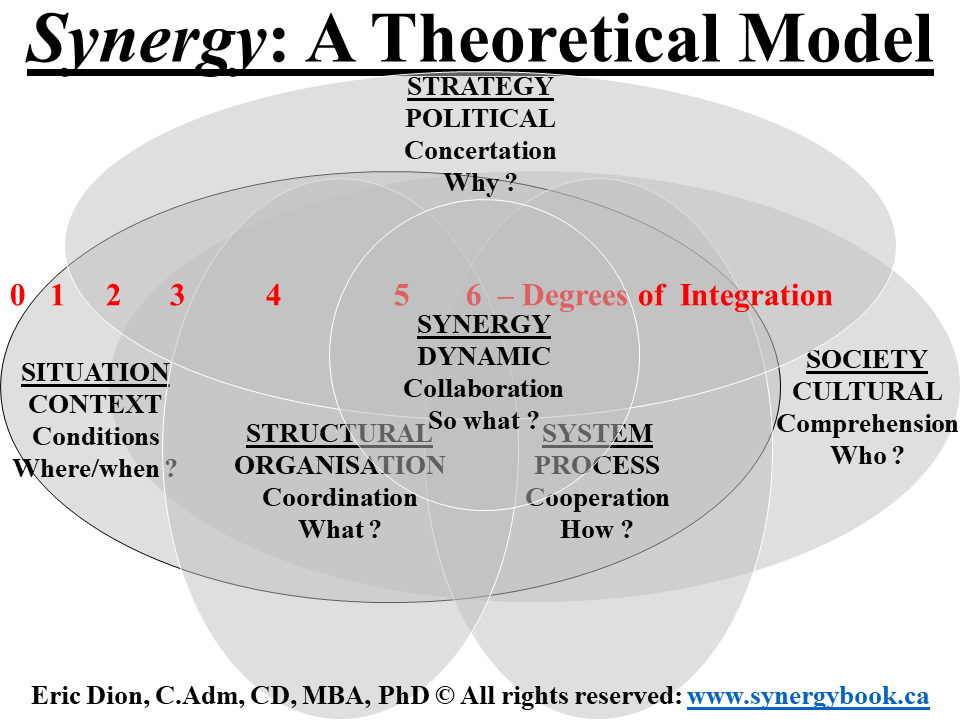It is recognized that managers today do not always attach importance to considerations that however seem fundamental in the era of new governance of our administrations. Indeed, in the face of increased global competitiveness in all dimensions, it is not only effectiveness and efficiency that will lead to excellence, but also considerations for the environment, equitability and ethics, as well as being energetic throughout. In short, it has thus become quintessential to leverage effects that yield greater added value or in other words, a “synergy of action”. This is the case for most entities, public and private administrations alike. But what about synergy? How to define it and above all, how to deliberately manage and maintain it?
The word synergy is a term we hear more and more. It is commonly understood that there is synergy when “The sum is greater than its parts”. The trouble is we often limit ourselves to this simple expression without defining the parts. For me, synergy is the dynamic combined effect of strategy, as well of a structure and a system taking into account the society and socio-culture, for a given situation. Synergy therefore integrates six dimensions, answering fundamental questions: Where and when [the situation], who and for whom [the society], what [the structure], how [the system], why [the strategy] and then so with what results [the synergy]. These questions are quintessential to grasp the essence of synergy, which is the sum of the parts or the six dimensions of the model.

Synergy is thus the combined effect of six dimensions, the first of which is the situation. It is the context, i.e. the dimension of space & time, conditions in which our action takes place. Historically, synergy comes from the Greek sunergia meaning working together; to collaborate. But collaboration does not happen in a vacuum. There needs to be an enabling environment, geographically and in time, hence the importance of asking the questions where and when. You can manage space and time, like when you are teleworking, videoconferencing, or even reading this editorial on the transit. This is the 1st significant dimension.
The second dimension is the societal or socio-culture. In sociology, synergy is more generally defined as the dynamic relationships between nations, social classes or people. But dynamic does not mean constructive. The societal, or sociocultural, dimension aims to ensure a common understanding of the key issues. It is important to ask who and for whom. This societal dimension is often neglected and we tend to consider it more implicitly while it is fundamental. It’s about thinking carefully about the unique socioculture of your organisation. Indeed, we do not think enough about the people who are at the heart of all activities. It is thanks to them that we can achieve excellence through effectiveness and efficiency, and it is for them that we must be equitable and ethical.
The third dimension to consider is structure. Architecture increasingly uses the idea of creating synergy, that is, a harmony between the environment [situation], people [society] and infrastructure [structure]. Concretely, it can be a physical structure or an infrastructure, but also an organisational one. We deal with this dimension by asking ourselves what it is concretely. Are we talking about a building, a business or a state? At base it is the idea of an institution and its organisational structure; the infamous organisation chart. But on its own this diagram does not represent socioculture nor the systemic process either; it is only the skeleton upon which we need to flesh out the other organs to bring life. And moreover, an executive reflex in the face of a glaring challenge is commonly to change the structure, whereas the structure itself does not solve much if we do not also act on the culture and on the system, on the strategy and on the situation, in order to achieve a higher degree of synergy.
Fourth is the systemic dimension. Here it is the processes and functioning that are important to us, from a global point of view. Sometimes the system dimension is associated with means, such as technology for example. But we will especially want to answer the question of how things work in practice; i.e. processes. It is understood that sometimes there are major differences between culture, structure and system. These are sources of significant frictions that undermine effectiveness and efficiency. I will come back to the main idea of synergy which is that of a better “fit” between dimensions but from a systemic perspective, the key processes must also be considered.
Strategy then obviously appears to be an important fifth dimension. In business strategy, we sometimes talk of synergy in the context of acquisitions and mergers. In the strategic dimension, we try to answer the question why we do things we do and we are sometimes simply happy to say, for profit or for the public, but it is much more than that in fact. Strategy is the very reason for being, the vision that we give ourselves that responds to why we want to excel. But this vision must still hold water and not just be a corporate level daydream… In the 1990s in particular, synergy was very popular but we were disillusioned because it was not well defined. Most executives were not managing it on purpose and also very deliberately as I suggest in my book: Synergy.
The 6th dimension, and not the least, is that of the dynamics. That’s when we talk about achieving synergy of action. Systematically as in pharmacology to treat cancer, for example, we speak of synergy when several anticancer drugs are combined in order to optimise the treatment by creating a synergy. Naturally, synergy is positive, a virtuous circle we want, while its opposite is a vicious circle we avoid. However, we can say that synergy in itself hardly exists in isolation and that it is very dynamic. The six dimensions are thus fundamental to understand the basic idea of creating synergy. As it is by definition “greater than the sum of its parts”, synergy emerges dynamically in action. The essence of the model is that synergy is created and managed by the integration of the six dimensions and therefore it is not chance. We must deliberately create and manage this synergy. So in short, such a synergy of action makes it possible to leverage effects with great added value. This is how synergy takes on its great added value from the sum of its parts in the six dimensions we thus presented. Henceforth, Canada should deliberately employ Synergy’s theoretical model in order to achieve greater effects.


